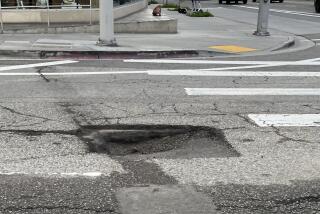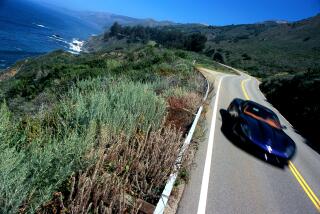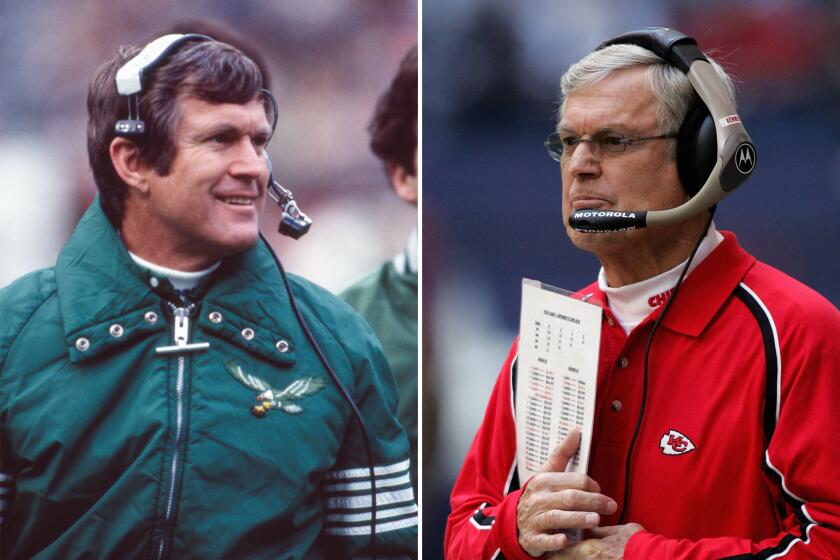Column: No. 17 at St. Andrews: lovable and unloved, a beautiful mistake

Tom Watson watches his shot from the 2nd tee during the first round of the 2015 British Open Golf Championship on The Old Course at St Andrews in Scotland.
- Share via
From St. Andrews, Scotland — If the Road Hole were on a major golf course in the U.S., somebody would change it. A corporate sponsor would demand it, or ESPN would balk at the camera positions.
This is Scotland. Thank God.
The Road Hole at the Old Course at St. Andrews, No. 17, is wonderfully dysfunctional. It’s a par-four that plays like a par-seven. It isn’t fair, it isn’t sensible. It is also loved and praised by all, even as they secretly hate it.
Take Tom Watson, for example.
He won the British Open five times, never at St. Andrews. He once had Seve Ballesteros in his sights for another win in 1984 and then hit a two-iron over the 17th green, over the road and up against the stone wall, where he could barely punch it out and took a bogey. Soon, Ballesteros was making a birdie and a fist pump on 18.
For Watson, it was over. Thank you, Road Hole.
At 65, Watson is still at it. So is the Road Course. He shot 76 in the opening round Thursday of this 144th British, and one of the holes he double-bogeyed was the Road Hole.
“Seventeen was the toughest flag position I’ve ever seen,” said Watson, who has played the British here seven previous times.
Take J.B. Holmes, for example.
By the time he got to the Road Hole, he was a pretty unhappy camper, anyway. On No. 15, a child picked up his ball after his drive. The child’s dad said to put it back. Nobody was sure whether it went back where it was found. Holmes asked for relief from a tower hazard. Didn’t get it. Made a seven.
Two holes later, his second shot flew just over the Road Hole’s narrow green, resting in the gravel path alongside. There is another strip of grass alongside the gravel path. That grass runs alongside the asphalt road, which gives way to a parallel strip of rough grass before you get to a stone wall.
Holmes chipped off the gravel into the hill next to the green, hoping to nudge it onto the green. Didn’t nudge enough. His fourth shot off the hilly green side rough stopped four feet away and he made the putt for bogey. He shot a one-over 73.
Without No. 15 and the Road Hole, he had a really good day.
Take Matteo Manassero of Italy, for example.
He was left of the six-foot-deep bunker to the left of the Road Hole green. They ought to name it Sandy Death, because hundreds of great golfers’ chances have died in there.
Manassero tried to chip over the bunker, to a pin just 10 feet beyond. But he hit the top of the bunker and his ball rolled back down and in. He wasted a shot getting out and took a seven. He shot 73.
Without the Road Hole, he had a really good day.
Take David Duval, for example.
In 2000, the year before he won the British, he was chasing eventual champion Tiger Woods, when he landed in the Road Hole bunker. He had to knock it out backward and took an eight.
Without the Road Hole, he might have had a really good day.
The horrors of the Road Hole start well before the green, bunker, road and stone wall. Indeed, its very name is a golf misnomer. You don’t have roads on golf holes.
The 495-yard nightmare demands a tee shot almost directly at the Old Course Hotel. The standard recommendation is to hit over the “O” in the name of the hotel on the side of a shed near the hotel swimming pool. If that conjures up images of scantily clad people, tending to cuts and bruises, you just deal with it.
Too far right of the “O,” you miss the fairway. Too far left of the “O,” you will bounce into an ugly patch of rough in the fairway that destroys approach angles. If you don’t get it high enough to clear the “O,” you are back at the cuts-and-bruises image.
A frequent instruction for amateurs here, from caddies who have observed and endured for 16 holes, is: “Laddie, let’s just try four nine-irons and a putter.”
The approach shot entails hitting a green, protected by the bunker. The green is turned sideways and about the width of a driveway. If you miss long and end up along the wall, you may end up replicating what veteran Miguel Angel Jimenez did in a European tour event. He hit the ball into the wall and it ricocheted onto the green.
Great shot. Even greater YouTube entry.
Putts traverse the usual bumps and lumps of these greens. Ocean winds swirl off the wall and hotel, and bagpipes play nonstop in the background, like it is necessary to be reminded that this is Scotland.
The 18th tee is mere steps off the back of the 17th green. Lee Westwood stepped away from his tee shot when an approach shot from the group behind landed with a thump.
Jordan Spieth had proper respect, or nicely disguised disdain, for the hole, during his opening round 67.
“On 17 today,” he said, “you purposely try to miss the green on the second shot. That kind of takes away the point of the hole, but at the same time, it’s the Road Hole at St. Andrews…”
Spieth bogeyed the hole out of the bunker. Tournament leader Dustin Johnson made a rare par.
The last time they played the British here, in 2010, the Road Hole was the toughest on the course, with a scoring average of 4.653. Thursday, former champion Mark Calcavecchia took a 9 there and European tour player Shane Lowry an eight.
A total of 156 players played it. There were no birdies.
The Road Hole was the first-day leader of the British Open.
Twitter: @DwyreLATimes.
More to Read
Go beyond the scoreboard
Get the latest on L.A.'s teams in the daily Sports Report newsletter.
You may occasionally receive promotional content from the Los Angeles Times.











